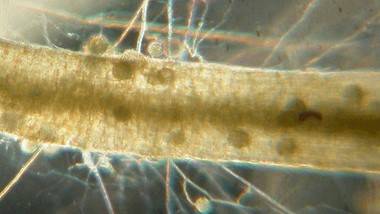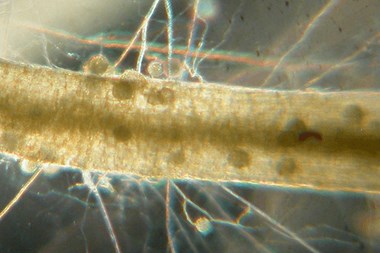Non-Living Plant Biostimulants: Can they benefit Your Crops? Part 1. Humic Substances


“Let’s give back to the rhizosphere whatever belongs to the rhizosphere.”
Biostimulants are becoming increasingly important in greenhouse and outdoor crop production. Many growers currently use living plant biostimulants, such as bacteria (e.g. Bacillus), fungi (e.g. mycorrhizae) and nematodes. However, there is a large class of non-living biostimulants which are organic compounds that are neither fertilizers nor biopesticides. Biostimulants help the plant to absorb water and nutrients more efficiently, and they can also protect the plant against pathogens. As a result, the plant will better tolerate environmental, nutritional and pathogen stresses, improving quality and yield. The use of biostimulants can be an alternative to synthetic chemicals, which can damage the natural populations of beneficial microorganisms that serve as biocontrols and produce biostimulants.

We will discuss the use of non-living plant biostimulants in two parts. In Part 1, we will discuss humic acids and their role in crop production. In Part 2 (next month), we will discuss the beneficial roles of vitamins, amino acids, seaweed and proteins in crop production.
Origin of Humic Substances
In the soil, animal and plant debris naturally break down by chemical or biological degradation. After many years, this debris is broken down into its smallest particle size and is known as humus. The color of humus can vary from dark brown to black due to the high content of organic carbon. Humus contains humic substances, such as fulvic acid, humic acid and humin, which are complex structures with high molecular weight. Humus also contains non-humic substances, such as carbohydrates, soil lipids and amino acids that have low molecular weights and are quickly degraded by soil microorganisms.
Humic substances are extracted from humates which are mined from humate ore deposits of oxidized lignite (leonardite) typically found in North Dakota. Nevertheless, humates can also be found in soil water, peat, coal and ocean water. After it is obtained from the mines, it is then separated into fulvic acid, humic acid and humin.
Components of humic substances
There are two main methods used to extract these humic substances from solid materials by using solutions of sodium hydroxide or potassium hydroxide. Either solution removes non humic substances, leaving behind humic substances. Next, the solution pH of humic substances is adjusted with an acid to drop the pH <2. Humic acid precipitates because it is insoluble at low pH whereas the fulvic acid remains in the solution (see Table 1). This process yields a higher concentration of fulvic acids than humic acids. The humins are not soluble in water at any pH (see Table 1) and sometimes alcohol is used to extract ulmic acid from humins, which can stimulate root growth.
The humic acid is then dried and typically sold in the form of prills, whereas the fulvic acids are commercially sold as liquid concentrates. Humates can also be produced as either mineral salts of humic or fulvic acids.
Based on the extraction solution technique mentioned above, humates can be either sodium humates or potassium humates. The first type is more often used as animal health supplement and the second is more widely used for crop production. Humates are made up of mostly carbon, hydrogen, oxygen, nitrogen, sulfur and phosphorus.
| Humins | Humic Acids | Fulvic Acids |
|---|---|---|
| Insoluble in water at any pH | Water insoluble at pH<2.0 | Water soluble at any pH |
| Ulmic acid is soluble in alcohol | Available as prills | Available as a liquid concentrate |
| Greatest molecular weight | Medium molecular weight | Lowest molecular weight |
| Highest carbon to oxygen ratio | Balance between oxygen and calbon | Highest oxygen to carbon ratio |
| Lowest Cation Exchange Capacity (CEC) | Medium CEC | Highest CEC |
| Reistant to decomposition, therefore improves soil structure and water holding capacity | Forms salts with inorganic trace elements | More chemically reactive |
Benefits of humates on the physical properties of mineral soil
- They act as a water reservoir for the plant. Water is readily available for the plant when it needs it.
- Used as soil conditioner to change the structure of the soil creating macropores which retain oxygen for the roots.
- Improve soil drainage.
- Promotes soil agglomeration and minimizes erosion
- Due to its dark color, solarization can increase soil temperature during the day.
- They reduce soil cracking.
Benefits of humates on the chemical properties of mineral soil
- Increases CEC and soil buffering capacity
- Improves soil fertility by coating soil particles and retaining Fe, Cu, Zn, Mg, Mn and Ca.
- They promote better nutrient uptake
- They react with Fe, Cu, Zn, Mg, Mn and Ca to form chelated substances.
- They immobilize aluminum in acidic soils
- They prevent the leaching of nutrients due to its electrostatic attraction with the nutrients
- Its charge helps to dissolve or bond trace elements.
- They help to stabilize nutrients
- Serve as a buffer for heavy metals
- Provide carbon to the microorganisms, promoting microbial growth for rapid remediation of soils and waste management.
- Humates feed microorganisms which solublize and release phosphates.
- They reduce soil pH by reacting with the calcium carbonate in the soil to produce carbon dioxide.
- Help to degrade or stabilize substances that are toxic to plants.
- Reduce the risk of metal cation toxicity in the root zone.
- Reduces sodium in the soil because it is exchanged with other cations which are more concentrated in the soil solution.
Benefits of humates for plants in general
- They have an auxin-like effect improving cell division and elongation.
- Fulvic acid has smaller molecular weight and can penetrate leaves, roots and stems while carrying different nutrients.
- Plants can easily obtain chelated nutrients because they are loosely bound to the chelate.
- They help improve plant defenses because the pathogenic enzymes are immobilized with humates.
- Humates can increase seed germination rates if they enter the seed. They speed up respiration and cell division.
- If applied foliarly, the chlorophyll content increases. This helps to increase oxygen uptake resulting in better plant growth.
- Plant benefits occur more quickly if humates are applied to the foliage, whereas it takes longer when applied to the soil.
- Plants take up substances better when the plant is actively growing.
- It is better to apply them to new leaves, shoots and roots.
- Root growth is improved and consequently uptake of nutrients and water is more efficient.
- Increases root respiration.
- If humate concentration in the soil is high then they are absorbed and transported to the leaves and shoots.
- When they are inside the plants, they can be involved in plant metabolism.
- Commercially, they can be available with plant nutrients which help to improve plant growth.
- Regulate plant growth hormones.
- Lantana camara grown in soilless mix increase biomass of roots and shoots with the application of humates (Costa et al, 2008).
- Pepper grown in soil mix increase biomass of roots and shoots with the application of humic acids (Cimrin et al, 2010)
- Tomato seedlings grown in soilless mix increase the nutrient uptake and dry matter of shoots and roots (David et al, 1994).
- Foliar application of humic acids reduce the nitrogen applications to the soil (Sani, 2014)
Cautions about the use of humates in agriculture
- Even though humates are difficult to decompose, they can be destroyed by excessive fertilization and excessive tillage.
- If they are applied to the foliage, then application rates must be lower; when applied to the soil, then rates are higher.
- The application rate will depend on the concentration of the product.
- Over application of humates can result in poor seed germination, seedling death and lower root dry weight.
- The quality of the humates varies and will depend on the origin, mining procedures and manufacturer.
- Apply humates right after or right before fertilization.
References:
- Cimrin, K. M., T. Onder, M. Turan and T. Burcu 2010 "Phosphorus and humic acid application alleviate salinity stress of pepper seedling" Journal of African Biotechnology. 9:5845-5851
- Costa, G., P. Labrousse, C. Bodin, S. Lhernould, M. Carlue, P. Krausz and F. Authier "Effects of humic substances on the rooting and development of woody plant cuttings" Acta Horticulturae: 779:255-261
- David, P. P., P. V. Nelson y D. C. Sanders. 1994. A humic acid improves growth of tomato seedling in solution culture. Journal of Plant Nutrition. 17(1), 173-184
- Sani, B. 2014. Foliar Application of Humic Acid on Plant Height in Canola. APCBEE Procedia 8(2014):82-86